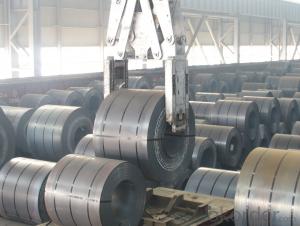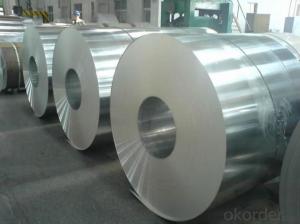Stainless Steel Coil Hot Rolled 304
- Loading Port:
- China Main Port
- Payment Terms:
- TT OR LC
- Min Order Qty:
- -
- Supply Capability:
- 5000 m.t./month
OKorder Service Pledge
OKorder Financial Service
You Might Also Like
Grade: | 300 Series | Standard: | JIS,AISI,ASTM,GB,DIN,EN etc | Thickness: | 2.5mm, 3.0mm, 4.0mm |
Width: | 550mm-1500mm | Length: | according to weight | Place of Origin: | China (Mainland) |
Brand Name: | CNBM | Model Number: | 304 | Technique: | Hot Rolled |
Application: | industry, construction, furniture, repairing | Certification: | MTC | Finishing: | NO.1 |
Market: | globle area | Packaged: | wooden and bags in cases as standard | Payment: | TT & LC |
Delivery time: | 15 days | MOQ: | 50 tons | Advantage: | prime quality, competitive price |
Profession: | hot rolled | Charactor: | stainless steel coils | Material/Grade: | 304 |
Hot Rolled Stainless Steel Coil 304
Specifications
1.surface:NO.1
2.standard:JIS, AISI, GB, DIN, EN etc
3.width: 0.55m, 0.65m, 1.0m, 1.22m, 1.5m, 2m or requirement
ASTM A240 304
(%):C=0.07, Mn=2.00, P=0.045, S=0.030, Si=0.075, Cr=17.5-19.5, Ni=8.0-10.5, N=0.10
Physical Properties
Tensile strength σb (MPa) ≥ 520
the conditions yield strength σ0.2 (MPa) ≥ 205,
elongation δ5 (%) ≥ 40
Reduction of ψ (%) ≥ 50,
hardness: ≤ 187
HB; ≤ 90
HRB; ≤ 200H
- Q: Can stainless steel strips be used in the production of cutlery?
- Indeed, cutlery production can make use of stainless steel strips. The popularity of stainless steel for cutlery stems from its exceptional resistance to corrosion and staining, as well as its impressive durability and strength. As a result, stainless steel strips are frequently employed as the primary material in the manufacturing process, as they can be easily molded and shaped into diverse utensil designs. Furthermore, these strips can be polished to achieve a desirable smooth and shiny surface for the cutlery. In conclusion, stainless steel strips possess the essential qualities needed to produce cutlery that is both of superior quality and long-lasting.
- Q: Are stainless steel strips suitable for decorative trim?
- Yes, stainless steel strips are suitable for decorative trim. They are durable, resistant to corrosion, and have a sleek and modern appearance, making them a popular choice for adding a touch of elegance and sophistication to various surfaces and areas.
- Q: Are stainless steel strips suitable for automotive trim?
- Yes, stainless steel strips are highly suitable for automotive trim. Stainless steel is a durable and corrosion-resistant material, making it perfect for exterior applications in the automotive industry. It provides a sleek and polished appearance, enhancing the overall aesthetic appeal of the vehicle. Moreover, stainless steel strips can withstand harsh environmental conditions, including extreme temperatures, moisture, and road debris, without losing their shine or integrity. Additionally, they are easy to clean and maintain, ensuring that the trim retains its pristine condition for an extended period. Overall, stainless steel strips offer excellent durability, aesthetics, and functionality, making them an ideal choice for automotive trim.
- Q: Can 111 stainless steel strips be coated or plated for added protection?
- 111 stainless steel strips have the capability to be coated or plated for extra protection. By adding a protective layer to the strips, their resistance to corrosion, wear, and other types of damage can be improved. The choice of coating or plating material will be determined by the desired level of protection and the intended application of the strips. When it comes to stainless steel, common coating options consist of epoxy, acrylic, and powder coatings, while plating options may include nickel, chrome, or zinc. To ensure the best coating or plating technique is selected, it is essential to thoroughly consider the intended use and environment of the strips.
- Q: What is the average lifespan of stainless steel strips?
- The average lifespan of stainless steel strips can vary depending on various factors such as the quality of the steel, the conditions it is exposed to, and how well it is maintained. However, in general, stainless steel strips can last for several decades and sometimes even longer if properly cared for.
- Q: What are the common dimensions of stainless steel strips?
- The dimensions of stainless steel strips can differ based on the particular application and industry in question. Nevertheless, there are several standard measurements that are commonly accessible. Stainless steel strips typically come in widths that range from 0.5 inches to 24 inches (1.27 cm to 60.96 cm) and thicknesses that range from 0.005 inches to 0.25 inches (0.0127 cm to 0.635 cm). Lengths may differ based on the supplier and the customer's requirements, but standard lengths are often approximately 12 feet (3.66 meters) or 20 feet (6.1 meters). It is worth mentioning that these measurements are not exhaustive and may fluctuate depending on the specific demands of the project or industry.
- Q: Can stainless steel strips be used in watchmaking?
- Yes, stainless steel strips can be used in watchmaking. Stainless steel is commonly used in watchmaking due to its durability, corrosion resistance, and aesthetic appeal. It is often used for watch cases, bands, and other components.
- Q: Can stainless steel strips be used in architectural column systems?
- Yes, stainless steel strips can be used in architectural column systems. Stainless steel is a durable and corrosion-resistant material that is suitable for architectural applications, including column systems. Its strength, versatility, and aesthetic appeal make it a popular choice in modern architectural designs.
- Q: How do you prevent galvanic corrosion of stainless steel strips?
- One effective method to prevent galvanic corrosion of stainless steel strips is by isolating them from any dissimilar metals. This can be achieved through the use of insulating materials such as non-conductive coatings or gaskets. Additionally, regular cleaning and maintenance to remove any foreign particles or contaminants that could initiate corrosion can help protect the stainless steel strips.
- Q: What are the common thicknesses of stainless steel strips?
- The common thicknesses of stainless steel strips vary depending on the intended application and industry standards. However, some of the most commonly used thicknesses for stainless steel strips range from 0.1mm to 3mm. These thicknesses are often used in various industries such as construction, automotive, aerospace, and manufacturing. It is important to note that specific thickness requirements may vary depending on the specific application, and it is always recommended to consult industry standards and specifications to ensure the appropriate thickness is selected for a particular project.
Send your message to us
Stainless Steel Coil Hot Rolled 304
- Loading Port:
- China Main Port
- Payment Terms:
- TT OR LC
- Min Order Qty:
- -
- Supply Capability:
- 5000 m.t./month
OKorder Service Pledge
OKorder Financial Service
Similar products
Hot products
Hot Searches
Related keywords






























